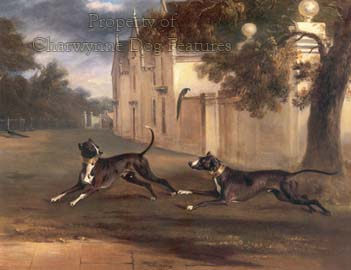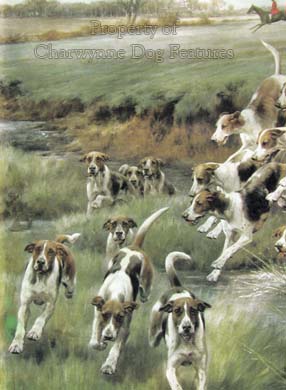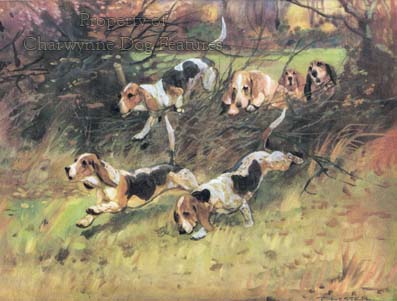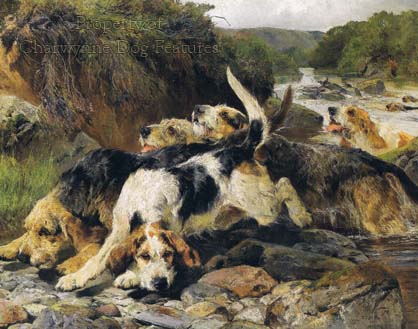416 Shoulder to Shoulder
SHOULDERING RESPONSIBILITY
by David Hancock
 It is surprising and disappointing to see foxhounds from a famous pack featuring upright shoulders. Even more surprising is to see them proudly depicted in houndshow photographs. Even more disappointing is to learn of their winning appearance at such a show. Upright shoulders are not exactly difficult to spot and are a considerable handicap to a hunting dog. Such a handicap means a limited forward reach and the forehand pulling instead of pushing on the ground. The position of the elbow on such a hound is too far forward and the line from throat to the front toes is straight, with no forward protrusion of the shoulder itself.
It is surprising and disappointing to see foxhounds from a famous pack featuring upright shoulders. Even more surprising is to see them proudly depicted in houndshow photographs. Even more disappointing is to learn of their winning appearance at such a show. Upright shoulders are not exactly difficult to spot and are a considerable handicap to a hunting dog. Such a handicap means a limited forward reach and the forehand pulling instead of pushing on the ground. The position of the elbow on such a hound is too far forward and the line from throat to the front toes is straight, with no forward protrusion of the shoulder itself.
If you study the writings and in particular the video made by the late Ronnie Wallace of hunting field fame, then you soon realise the importance to the hound of good shoulders. The video, Hound Standards (Countryside Audio and Visual), covers the conformation of the various hounds of the pack; it should be required listening for any show judge. Ronnie Wallace, the presenter, was chairman of the Master of Foxhounds Association for 22 years and hunted 9 different packs of hounds. His writings too have just been published in 'A Manual of Foxhunting', edited by Michael Clayton. Ronnie Wallace's genius as a hound breeder and his extraordinary achievements as a Master of Foxhounds made him a legend in his own lifetime. He should be listened to.
Wallace's advice on judging hounds is illuminating; he considers the shoulders the key to sound construction. Another famous hunting man, the late Sir Newton Rycroft, once wrote of a suberb Beagle, Old Berkeley Rompish '39, in the hunting field "...she went past the whole pack to take the lead as a thoroughbred would outclass vanners. She was one of the smallest bitches in kennel but the only one with perfect shoulders." Wallace and Rycroft were the great hound experts of the 20th century, their words are of immense value. Every show ring judge must judge shoulders with a knowledgeable eye. Winning hounds get bred from!
Expressions like 'lay of shoulder', 'well-laid shoulders' and 'sloping shoulders' are used by many without any clear concept of their implications, and, more important, the reason for their inclusion. Tom Horner, the great terrier judge, wrote extensively on this very point. His words are of value to judges of hounds and should never be scoffed at because they have been written by a terrier expert.
In his informative 'All About The Bull Terrier' of 1973 (Pelham Books), Horner wrote: "...to secure the very important good lay back of shoulders, it is necessary for the dorsal bones to be of good length. Well laid back shoulders are highly desirable for a number of reasons, a well laid shoulder has a firmer attachment to the chest wall than an upright one, it is also likely to be matched by a good length of upper arm, which, in turn, will mean that the elbow will be placed well back from the forechest, and the foreleg will have freedom to reach out well in movement." The stilted abbreviated front movement of so many show ring terrier breeds illustrates the limitation imposed on a dog's forward movement by a lack of slope in the shoulders and a lack of length in the upper arm.
It is easier to judge the shoulders of a short-coated self-coloured exhibit than any other. In a parti-coloured dog the patches on the shoulder can affect the way the human eye accepts the symmetry of the dog. On a black merle lurcher, for example, a solid black patch over the whole shoulder, contrasts memorably with mainly white legs and a lighter-covered body; this can 'throw' the eye of the beholder and affect judgement.
For me, the first point of real quality in a dog lies in clean sloping shoulders. Well-placed shoulders give a perfect base for a proud head carriage. They provide too the balance between the length of the neck and the length of the back, preventing those disagreeable dips in topline which mar the whole appearance of a dog. I have learnt, over the years, to start any judgement of the shoulders by considering the position of the elbow. If the elbow is too far forward, then the dog is pulling itself along, not pushing itself along, not capitalising on the drive from the hocks, thighs and loins. In his video on the packhounds, Capt Wallace states that the shoulders are controlled by the elbow. He is worth heeding.
It is only when the scapula and the humerus are of the right length and correctly placed that a dog can achieve the desired length of stride and freedom in his front action. Sighthounds can have their upper arms 20% longer than their scapulae. In smaller breeds they tend to be equal in length. Dogs which step short in front are nearly always handicapped by upright shoulders and short steep upper arms. A dog of quality must have sloping shoulders and compatible upper arms to produce a good length of neck, a firm topline without dips, the right length of back and free movement on the forehand. Even when there is a discernible curve in the topline, as in the Borzoi and the Bedlington Terrier, well laid shoulders are required to produce the correct topline, with the arch in the spine starting in the correct place. The correct Borzoi and Bedlington 'arch' position is over the loins, to enable the dog to bring its hindfeet forwards, in front of the chest when galloping, without any restriction from the ribs.
When judging 'galloping breeds' I always check the space between their shoulder blades at the withers. If you check this space, say, to compare a show greyhound with a coursing dog, by placing a finger between the two scapulae and then getting the dog to lower its head, you can soon spot the difference. The show dog's scapulae will squeeze your finger as the dog's head goes down; the coursing dog's scapulae will remain apart. In extreme cases this means that the show specimen would be quite unable to pick up a rabbit or even drink from a bowl on the floor, without adjusting its forelimbs. It is not good sense for the Greyhound's standard to demand shoulders that are 'narrow and cleanly defined at the top'; this can create a difficulty when the dog lowers its head. 
The racing front involves an extremely long upper arm, often dropping the elbow below the brisket line. I have heard show judges declare this feature to be undesirable, even 'shelly'. But most of the desert Salukis I have seen hunt with great success possessed this feature, as do many quality lurchers. In the Dachshund front, the whole forehand structure is reduced in length of bones; the elbow action arc being actually above the brisket line. Many dogs which are loose at elbow are tight at the shoulder joint, the forelegs tending to be thrown out sideways in a circular movement. If the dog is tight at elbow the whole leg inclines outwards, making the dog 'paddle', ie move the feet in an arc to the side. Loose elbows are often accompanied by other front leg faults: slack pasterns, splayed feet or feet which turn in or out. Dogs with correctly sloping shoulders and compatible upper arms rarely have such a problem.
When shoulders are correctly sloped, the topline runs through much more smoothly, giving a far cleaner look. The shortening of the neck from the forward placement of the shoulders does seriously impede a working dog. A retriever, for example, with such a feature has to make so much more effort to pick up game or carry it over an obstacle or when swimming with it. Short-necked dogs tire far more quickly than soundly constructed ones. A few years ago, when making a commercial video on the Labrador Retriever, we were filming on the Sandringham estate and it was a joy to see the quite beautiful necks and shoulders of the sleek very fast black Labs which we filmed. No working dog deserves incompetent breeding bestowing handicapping features on it. When moving, 60 to 70% of a dog's weight is distributed on the front legs; the forequarter construction decides the soundness of the dog's movement.
Tom Horner wrote that 'Long-arched necks give flexibility to the head carriage and usually go along with good shoulder placement, the two combining to give the dog an air of quality and style'. Long cervical bones, long dorsal bones, a 'bump in the front', adequate upper arm length and a gap between the scapulae at the withers are not difficult to detect when viewing and 'going over' an exhibit. R H Smythe, sportsman, vet, writer and exhibitor, once owned a brace of highly successful show Greyhounds, both over 27" in height, which could outrace a hare but never catch one. He also had a coursing Greyhound, 25" high, with 2½ fingers' width between the blade-bones, which once picked up 57 rabbits in three hours 'lamping' in similar country. The show Greyhounds were handicapped dogs, in the physical sense.
A famous Newmarket trainer used to stress 'No shoulder, no horse!' A famous professional huntsman once advised 'Necks and shoulders! get the necks and shoulders and the rest will come!' These are the cries needed for soundly-built dogs; we select the breeding stock, so we shoulder the blame. Before we talk 'stud fee', let me see, and place hands on, your dog's shoulders! Let's shoulder responsibility rather than blame.